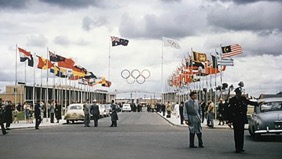The Rio Olympic Games 2016 remind us it is exactly sixty years since our own city Melbourne proudly hosted the 1956 Games. Clearly much has changed in this time.
In Melbourne 3314 athletes represented 72 countries in 17 sports at 9 venues. In Rio there were over 11000 athletes representing 207 countries in 28 sports at 38 venues.
| MELBOURNE 1956 | RIO 2016 | ||
| Mens 100m | 10.5 (Morrow, USA) | 9.81 (Bolt, Jam) | |
| Womens 100m | 11.5 (Cuthbert, Aus) | 10.71 (Thompson, Jam) | |
| Mens 10000m | 28:45.6 (Kouts, USSR) | 27:05.17 (Farah, UK) | |
| Mens 100m Freestyle | 55.4 (Henricks, Aus) | 47.58 (Chalmers, Aus) | |
| Womens 100m Freestyle | 1:02.0 (Fraser, Aus) | 52.70 (Manuel, USA) | |
| Mens 1500m Freestyle | 17:58.9 (Rose, Aus) | 14:44.51 (Paltrinieri, Ita) | |
| Womens 400m Freestyle | 4:54.6 (Crapp, Aus) | 3:56.46 (Ledecky, USA) | |
Medicine and especially sports medicine has also progressed significantly so it is interesting to look back at the official records relating to medical services (Official Report of the Organizing Committee for the Games of the XVI Olympiad Melbourne 1956, pub 1958):
MISSION
To ensure health, well-being and physical fitness of highly trained athletes, at all venues and the village.
ORGANIZATION
The Organizing Committee formed a Sub-Committee to be responsible for the medical services at the village and venues. This committee comprised Melbourne doctors and representatives of the three Armed Services and was chaired by Dr HG Furnell, a gynaecologist at St Vincents Hospital. Also on the committee was Major-General WD Refshauge who has an annual lecture named after him at the Sports Medicine Australia national conference.
STAFFING
120 doctors volunteered via an appeal through the Medical Journal of Australia with an Air Force officer appointed as Medical Superintendent at Heidelberg Village Medical Centre with 2 senior registrars seconded in turn from the major teaching hospitals.
Nursing and orderly staff were supplied by the Armed services and it was ensured that private nursing sisters gave free service in the medical rooms at all times women were competing.
EQUIPMENT
Armed services also provided the medical equipment without charge.
An electrical company lent and installed Xray and physiotherapy equipment. Other companies provided supplies, including the Red Cross Society.
VACCINATIONS AND INOCULATIONS
Given a mixture of sea and air transport to the Games vaccinations were difficult requiring the possibility of last minute inoculation if an epidemic occurred whilst teams were in transit (especially if travelling through Cholera areas).
HEIDELBERG VILLAGE MEDICAL CENTRE
The Olympic village was located at West Heidelberg where little obvious signs of its history remain apart from Olympic Rings which hang over what was the entrance to the former athletes dining hall. The accommodation was handed over to public housing after the Games and remains in need of renewal.
The medical centre occupied 2 blocks each of 4 houses and 4 flats. There was also a Village hospital with 24 beds available in separate houses. Services provided included medicine, X-ray, dental, physiotherapy and chiropody all provided for free apart from physiotherapy.
Some of the larger teams set aside a portion of their accommodation for use by their own medical officers.
Arrangements were made for serious cases to be transported to St Vincents Hospital, one of Melbourne’s principal teaching hospitals. Separate arrangements were made for infectious diseases.
VENUES
Stocked and staffed medical rooms were provided at or near all venues with orthopaedic or general surgeons on duty depending on the sport, and female doctors for female competitors.
First aid kits were provided at training venues with local doctors available on call.
AMBULANCES
Were provided by the local civil ambulance service and also Air Force ambulances for road events and the village.
FIRST AID
Provided by St Johns Ambulance Brigade as characteristic for their service.
MEDICAL STATISTICS
A total of 1553 treatments were provided to athletes and 112 to officials over the period of the games and categorized using official codes.
As expected the majority of these were described as accidental injury with the usual skin infections and upper respiratory tract infections seen amongst athletes living in close quarters. The games were held in late November (spring) which may explain the incidence of allergies, and were uncharacteristically wet.
There were 5 cases of appendicitis presumably which went to surgery although these details are unavailable. Not surprisingly the 4 cases of arteriosclerotic and degenerative heart disease were limited to the officials. Interestingly there were 9 cases of psychoneuroses or psychoses reported exclusively amongst male athletes!
Andrew Jowett is a Sport and Exercise Physician at OPSMC’s Olympic Park Campus.
Patients can book appointments with Andrew by calling our friendly receptionists on 1300859887.